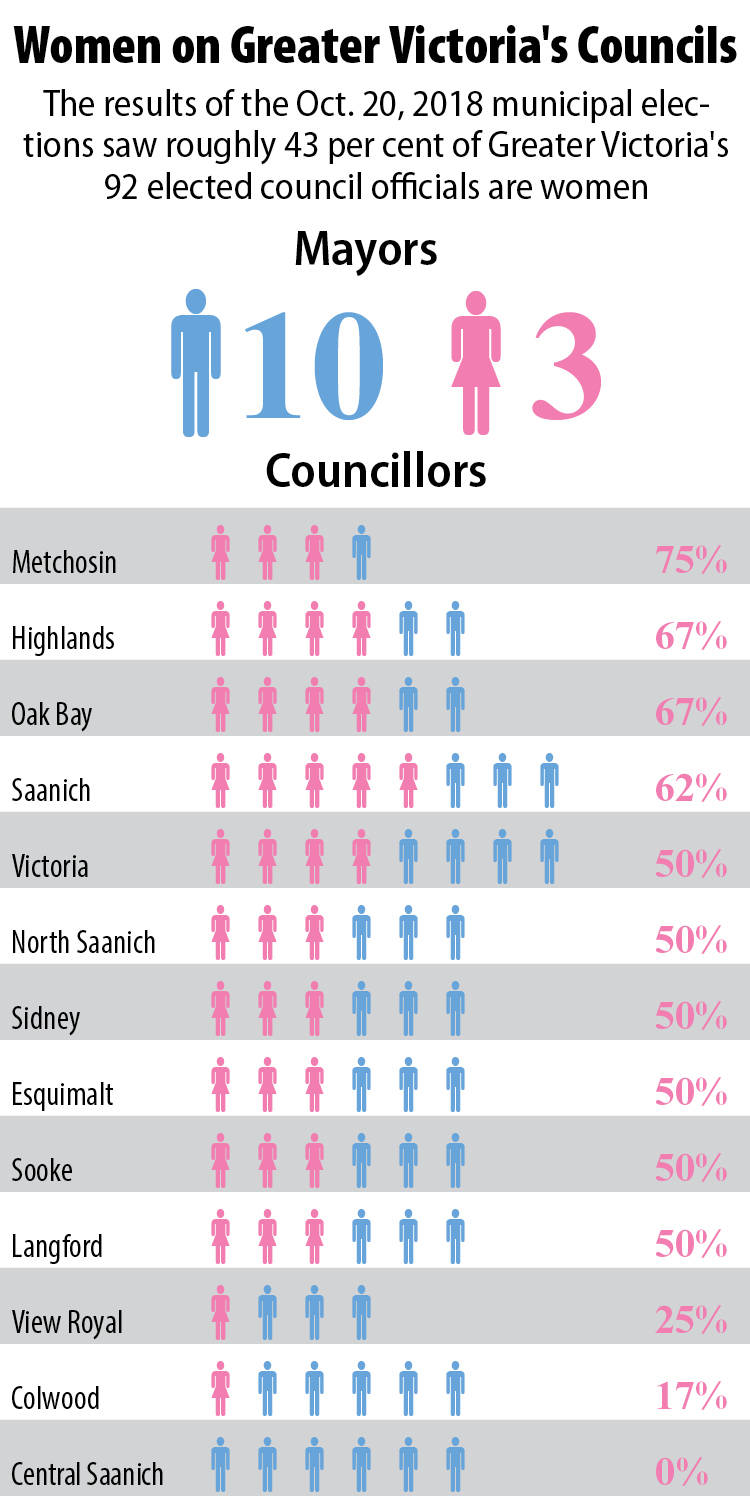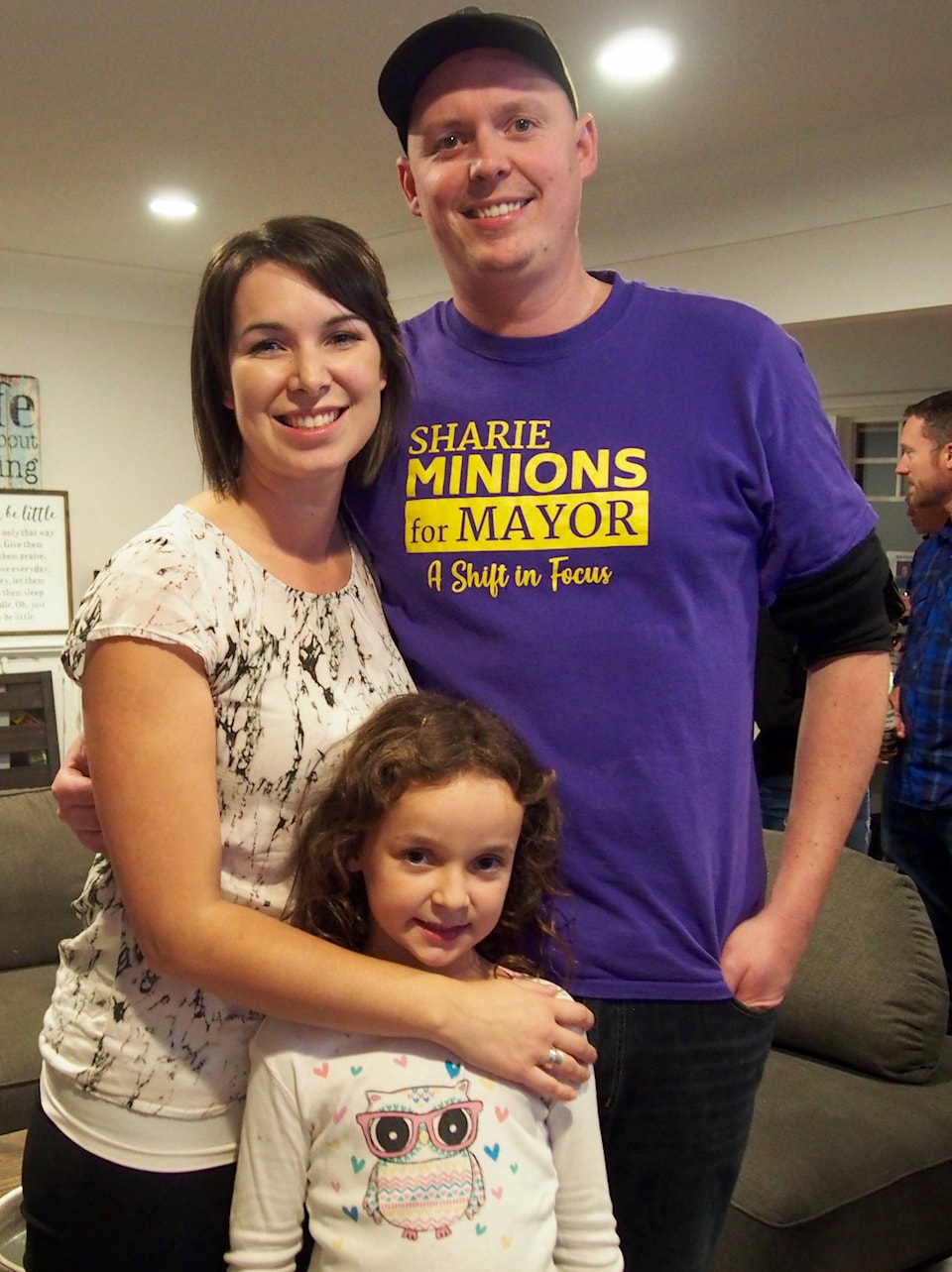BY MIKE YOUDS AND JOHN MCKINLEY
There was a time when the current Qualicum Beach and Central Saanich councils wouldn’t have been all that remarkable.
That was the time of John Wayne, Leave it to Beaver and Father Knows Best.
Today, the all-male municipal councils elected earlier this month to lead those two communities stick out like a candy-apple red 1962 Chrysler puffing out clouds of high-octane leaded gasoline in a downtown Victoria bike lane.
Vancouver Island elected women on Oct. 20.
Maybe not in Qualicum Beach and Central Saanich, and maybe not to the point where they are dominating the decision-making process. But enough to make one wonder whether gender equity in city hall has actually become a thing.
Of the 242 seats available in 36 Vancouver Island communities in the Oct. 20 municipal election, women filled 101 of them — about 42 per cent and an increase of about nine per cent over 2014. Seventeen of the 36 councils have more women than men. Nine have female mayors.
RELATED: Women make up nearly 50 per cent of Greater Victoria area councils
Port Alberni council elected its first female-dominated council, climbing from 15 percent female in the last election to 57 percent today — a pronounced shift.
Mayor-elect Sharie Minions isn’t the first woman to lead the city — that distinction is held by Gillian Trumper who served from 1983-2001 — but she is the first to lead a gender-balanced group of city councillors. Debbie Haggard, Cindy Solda and Helen Poon will be joining Dan Washington, Ron Corbeil and Ron Paulson on the new council.
Minutes after results were announced, Minions credited people such as Theresa Kingston and Patty Edwards for encouraging more women to step forward. The pair organized two springtime sessions in the city intended to increase the number of women in politics.
But Kingston wasn’t accepting any credit for the outcome. She doesn’t feel voters marked their ballots with gender as a deciding factor.
“I think that the community selected, in their minds, the best people for council,” Kingston said. “I don’t believe people voted based on gender, and I think that’s really important.”
She pointed out that the Women in Government sessions were focused on encouraging women to run rather than encouraging people to vote for women based on gender. Part of the research in preparation for those sessions indicated that women are more likely to enter politics with peer encouragement.
“For women to run, women need to be asked to run, they won’t just step forward. That hasn’t happened in the past in this community, but I think it’s happening North America-wide.”
RELATED: Why don’t more women run for local government
It wasn’t always that way. A look back at the 1950 council photos of North Cowichan, Nanaimo and Victoria reveals just two exceptions to a pronounced pattern of “middle-aged, suit-clad and male.” It took until 1985 for Victoria to elect a female mayor, Gretchen Brewin. Nanaimo followed suit in 1990, when Joy Leach was elected. Ann Murray became the first woman to lead North Cowichan in 1996. Saanich has yet to elect a woman as mayor.
In 2018, Michelle Staples became Duncan’s first female mayor. Also noteworthy, Josie Osborne was returned to the Tofino mayoralty for a third term with an 85 percent mandate. Every woman who ran in Comox was elected. Same thing in Ladysmith. Port McNeill, Gold River, Zeballos, Comox, Cumberland, Tofino, Ucluelet, Lake Cowichan, Duncan, Sooke, Metchosin, Highlands, Esquimalt, Oak Bay, Saanich and Victoria join Port Alberni as councils where women outnumber the men.
All a matter of coincidence?
“In the six elections I’ve been in, this is the most,” said Solda, who pointed to The Women Lead Movement as being influential globally.
“It’s been really prominent,” she said. “Even four years ago, before the last election, there was big movement. There’s a big push for women to start getting out there.”
Women can bring a different skill set and set of experiences to elected office, said Solda, who ran because she loves a challenge and enjoyed her past political experiences.
The Federation of Canadian Municipalities is another organization that has taken a proactive approach to encourage more women to run for office, Kingston noted.
“It’s something that’s been focused on in the last couple of years,” she added, describing it as collective awareness rather than a single motivating factor.
Haggard, who drew the most votes of any Port Alberni election candidate, said it’s important to have diversity on council as well as experience. All those elected are well-qualified to hold office, she added.
She was among local women who attended one of the sessions last spring, encouraging women to encourage other women.
“I got really strong encouragement to run,” Haggard said. “It was a very important factor having that support.”
EDITORIAL: Women’s voices need to be heard
Meanwhile, Ashwak Sirri, chairwoman of Equal Voice Central Vancouver Island, told the Nanaimo News Bulletin that her group’s hope going into election day was for gender parity.
“Numerous studies demonstrate that if women are represented fairly in political systems it benefits everyone in society. These studies show that gender parity has a positive impact on governance, democratic systems and in specific areas such as health and education,” she wrote in an e-mail to Black Press.
“Finally, we would like to say a big thank you to all of the women who put their names forward. We know from our experience that it is particularly difficult for women to do this and we are humbled by those who found the courage to run for office.”
—with files from Black Press
Gender balance on Vancouver Island councils
Port Hardy: three of six councillors are women (1/6 in 2014)
Port McNeill: mayor and two of four councillors are women (mayor, 1/4)
Alert Bay: two of four councillors are women (2/4)
Port Alice: two of four councillors are women (mayor, 1/4)
Gold River: three of four concillors are women (1/4)
Zeballos: the mayor and two of four concillors are women (3/4)
Tahsis: two of four concillors are women (mayor, 2/4)
Sayward: one of four concillors are women (3/4)
Campbell River: three of six councillors women (3/6)
Courtenay: two of six councillors women (1/6)
Comox: four of six councillors women (3/6)
Cumberland: mayor and three of four councillors women (mayor, 2/4)
Qualicum Beach: council entirely men (1/4)
Parksville: two of six councillors women (4/6)
Tofino: mayor and three of six councillors women (mayor, 2/4)
Ucluelet: four of four councillors women (mayor, 2/4)
Port Alberni: mayor and three of six councillors women (1/6)
Lantzville: one of four councillors are women (2/6)
Nanaimo: three of eight councillors women (2/8)
Ladysmith: two of six councillors women (1/6)
North Cowichan: three of six councillors women (3/6)
Lake Cowichan: three of four councillors women (2/4)
Duncan: mayor and three of six councillors women (3/6)
Sooke: mayor and three of six councillors women (mayor, 4/6)
Metchosin: three of four councillors women (2/4)
Highlands: four of six councillors women (4/6)
Langford: three of six councillors women (3/6)
Colwood: one of six councillors women (mayor, 2/6)
View Royal: one of six councillors women (1/4)
Esquimalt: mayor and three of six councillors women (mayor, 5/6)
Victoria: mayor and four of eight councillors women (mayor, 4/8)
Oak Bay: four of six councillors women (3/6)
Saanich: five of eight councillors women (3/8)
Central Saanich: council entirely men (1/6)
North Saanich: three of six councillors women (mayor, 2/6)
Sidney: three of six councillors women (2/6)




